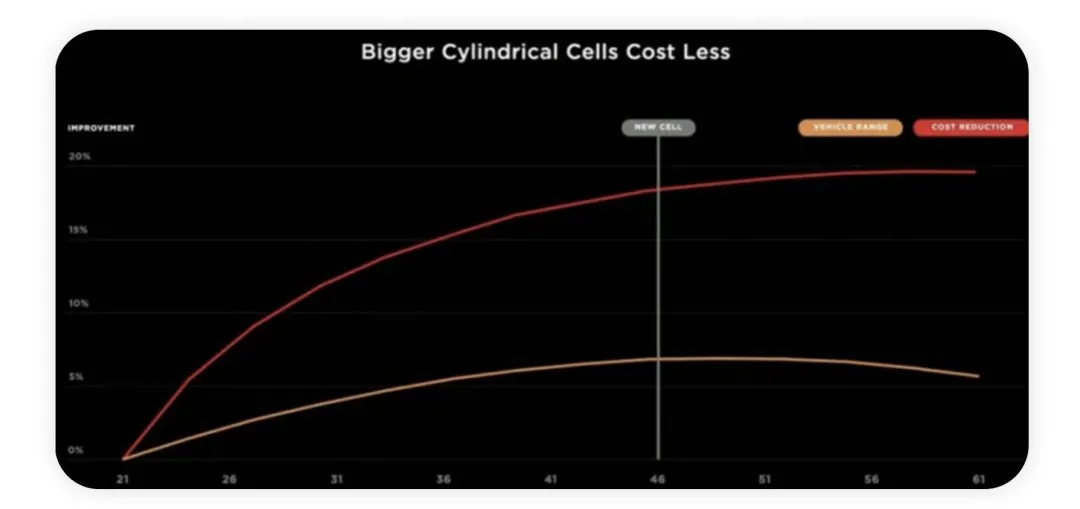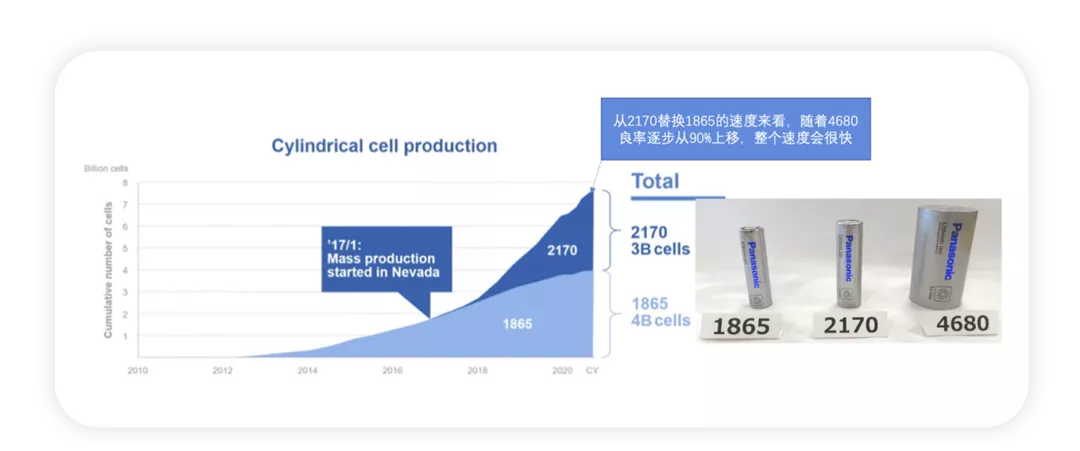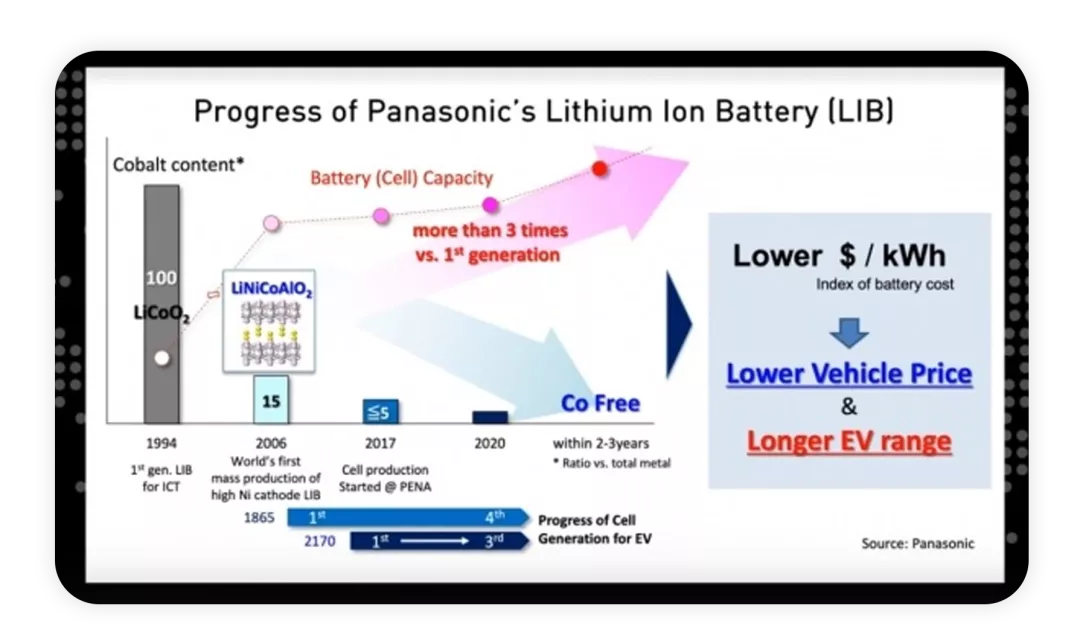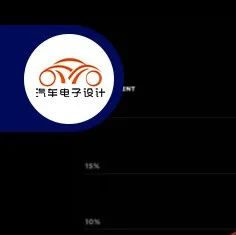Talked with industry chain friends about Tesla’s 4680 battery, which requires updates from various dimensions of the industry chain. From the current perspective, high-nickel cylindrical batteries are a relatively realistic solution for short-term breakthroughs in the increasingly intense competition of lithium iron phosphate industry.
The process optimization of the 4680 battery has been carried out for a long time. This is Tesla’s first self-produced battery. However, there are still some difficulties in the production line and supply chain selection.
Research Content
● Yield Issue
The 4680 battery has been researched since 2019. The initial concept design was proposed by Panasonic and a European chemical laboratory, and was optimized and improved based on the theory of full ear. From this perspective, there is a disconnection between battery development and battery manufacturing, that is, the difference in yield has not been reflected in this graph.
Note: A yield of around 95% in the short term could be a good number for the 4680 battery, while the yield for the 2170 battery could be around 99%.

From the laboratory to the early production line, Tesla absorbed a lot of talents from battery suppliers to delve into the field of batteries. The yield rate was only about 15% to 20% at the beginning. With the improvement of process improvement measures, the yield rate has gradually increased from 80% and is expected to achieve 88-90% in early 2022.
◎In reality, with an 80% yield rate, the large-scale production of the 4680 battery is not economical. However, even if the ideal yield rate cannot be achieved in 2022, Tesla still needs to promote the landing of the 4680 battery on a large scale.
◎From the current reality, the economic feasibility of large-scale production of the 4680 battery has set a benchmark point of 90% yield rate.
● Application Range of 4680
The first use of Tesla’s 4680 battery was originally planned for the Model Y at the Berlin factory, but European deliveries have been postponed.
From the current perspective, both Europe and North America are promoting the 4680 battery, with Berlin mainly making the Model Y and the United States using it on the Model Y first.
With the increase in future yield rates and cost reductions, the battery could potentially be used on the Model S and Model X.
 ### Why 4680 is Used in Cybertruck?
### Why 4680 is Used in Cybertruck?
So far, the higher energy density and excellent charge-discharge performance of the 4680 battery have made it a suitable choice for Cybertrucks, which primarily serve the demand in the North American region. Currently, Rivian and the joint ventures of Ford and General Motors are all aggressively promoting such vehicles. Due to their large payload and driving range requirements, pickup trucks are naturally heavier, which gives rise to comparatively higher demands for battery cell performance. Thus, the difference between using 18650 and 4680 battery cells in Model S Plaid is insignificant; however, in Cybertruck with over 150 kWh, energy density brings a considerable difference.
Progress of External Suppliers of 4680
Similar to Volkswagen’s definition of the 590 module, Tesla’s introduction of the 4680 battery has become a worldwide test for all battery manufacturers. Currently, all vendors, including Panasonic, LG, SDI, CATL, EVE, Gotion, and A123 Systems, are still addressing yield issues in mass production. From the perspective of the 4680’s specifications, battery sample tests can indicate the potential product performance. However, 4680 encounters large-scale manufacturing challenges, which make it different from experimental or pilot-run products. Therefore, for Tesla, having the design for the 4680 battery cell in its pocket implies that subsequent large-scale replacement of battery cells should be effortless.
Note: Standardizing the 4680 battery cell is an attempt to relinquish control to auto manufacturers worldwide. In other words, definitions of VW battery cells, Volvo battery cells, and even Toyota battery cells would lack the ability to standardize battery cells, which complicates aligning battery producers worldwide on a common ground.
Different Routes for 4680 Battery Cell Technologies
The 4680’s requirements only restrict its size and bipolar ear design methods. From the current state of affairs, different companies are evaluating diversified technologies. For example, compared with the welding process of bipolar ears, the path to cutting and press forming is more viable. The actual yield rate and anticipated yield rate of different routes are different.
The 4680 battery cell’s structure is significantly different from that of the 21700 because of the variance in the bipolar ear design (flow forming). The 4680’s overall architecture is composed of a single layer of diaphragm, and at both ends, a layer of copper and aluminum foil is used as negative and positive electrodes, respectively. However, during the winding process, short circuits between positive and negative electrodes might occur (which would produce faulty products when the self-discharging current reaches a certain level).
Regarding welding, the overall packaging process of 4680 batteries increases the weld circumference and time, which results in significant challenges for equipment accuracy in improving the success rate or reducing the process’s time. The blank space left for the bipolar ears and flow-forming body of 4680 batteries is limited, affecting its consistency, which leads to the probability of skipping the overall welding mode.
From the perspective of the internal structure, uneven coating during fish-scale coating technology reduces the quality rate.#### From the perspective of battery materials, Panasonic uses NCA and the low cobalt materials being developed for its next generation batteries, which are currently being tested in Japan and the United States.

-
Tesla’s first generation 4680 positive electrode system has a higher nickel content than the NCM811 NCM 91 system.
-
LG is currently using NCMA for its positive electrodes.
Pros and Cons of 4680
Currently, the disadvantage of the 4680 battery seems to be its cycle life, which is slightly worse than the 21700 battery during its suitable operating period due to its larger size. However, its biggest advantage is its improved layout. During the PACK stage, the 4680 battery has a 40% increase in volume compared to the 21700 battery, while the energy density comparison is around 30%.
Under the premise of consistent yield rates, the cost of a single cell drops by about 20% when compared by kilogram and watt-hour. In terms of ideal Pack design, the 4680 battery can reduce battery platform costs by 50%-60%, mainly related to battery system manufacturing costs + material costs + vehicle assembly and material costs.
The core advantage is to improve the efficiency of electric vehicle assembly. The production speed can be increased by 30%, and many parts can be eliminated in the production process by design, such as the battery cover, heat dissipation pipeline, module fixing structure, and valve body, directly reducing costs.
Conclusion: These contents are quite important, and I will continue to follow up on this subject and share any observed information with everyone.
This article is a translation by ChatGPT of a Chinese report from 42HOW. If you have any questions about it, please email bd@42how.com.
